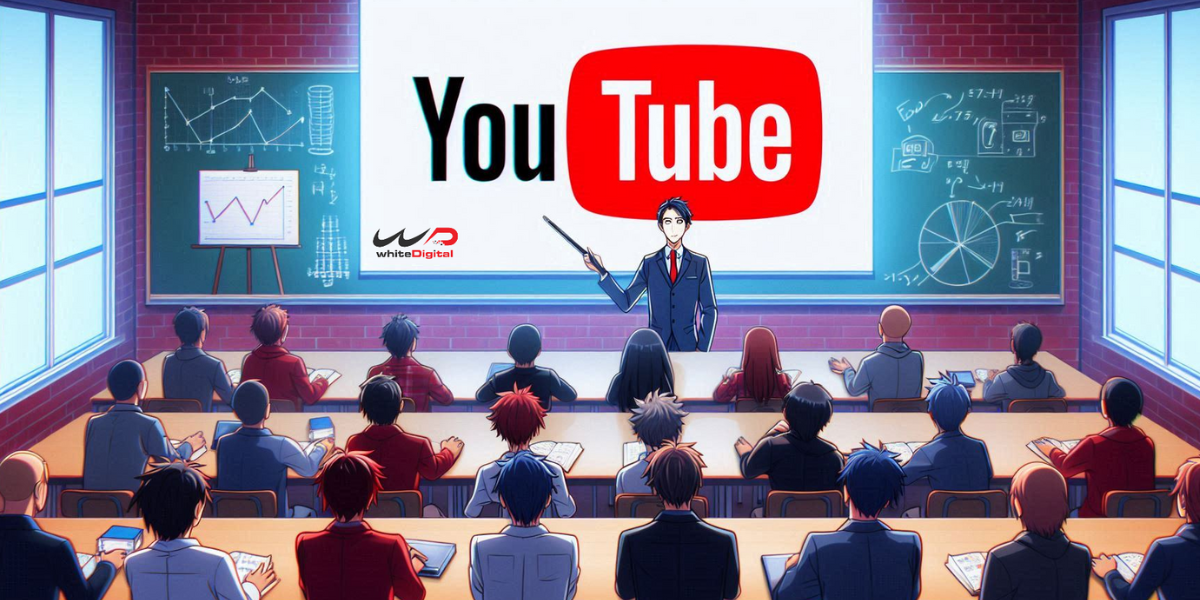When it comes to advertising platforms, YouTube holds a strong potential, which can drive sales to your client’s business. With billions of users using YouTube worldwide, YouTube provides the lowest advertising costs and the growing preference for video.
With over 2 billion monthly active users and 5 billion videos viewed daily, YouTube has become the go-to platform for businesses and marketers seeking to reach their target audience.
Advertising on this platform comes with a huge opportunity to gain a huge level of audience and customers for your client’s business.
You might wonder why it really matters. YouTube advertising matters because 70% of YouTube viewers report buying a product after seeing an ad and YouTube ads reach 70% of the online adult population in the US
YouTube can be used to drive brand awareness and generate leads and sales, which will help the business grow. However, to generate leads, you need to know who your client’s target audience is, and more importantly, you need to ensure that the target audience doesn’t skip your ad.
Whether your client is a seasoned marketer or an amateur just getting started in this guide, we’re going to take you through every element that you need to know about YouTube advertising. With that, let’s get started.
Table of content
- What is YouTube advertising?
- Why is YouTube Advertising important for advertisers?
- Understanding YouTube Ad Types
- YouTube Ad Targeting and Pricing
- What Are the Benefits Of YouTube Advertising?
- Setting Up a YouTube Advertising Campaign
- YouTube Ad Specifications you need to know
- Why do advertisers choose YouTube ads?
- YouTube Advertising Trends and Best Practices for 2024
- Key Takeaways
What is YouTube advertising?
YouTube advertising is a method to market your business using YouTube. There are multiple advertising formats that the platform provides to help businesses and individuals reach their target audience, build brand awareness, and drive sales.
There are various types of advertising formats, starting with video ads, display ads, non-video ads, interactive ads, and live streaming ads.
YouTube advertising platforms include Google AdWords (now Google Ads), YouTube Studio, and Google Ad Manager.
YouTube is a powerful platform for advertising, but it’s also the most reliable option out there. YouTube offers niche targeting options, which include:
- Demographic targeting (age, location, language)
- Interest targeting (topics, keywords)
- Behavioral targeting (user behavior, interests)
- Lookalike targeting (similar audiences)
- Custom targeting (uploading customer lists)
- Contextual targeting (video content, keywords)
These targeting options make it easy for businesses to get in front of their audience and reach their potential customers. Marketing is a statistical game and the more refined your method is, the more leads you’ll attract.
With the changing marketing dimensions, YouTube still stands out as a powerful platform to give good results. With a massive reach of billions, you can spread good brand awareness in a flexible ad format. YouTube advertising is a solid way to gain more customers for your business.
Why is YouTube Advertising important for advertisers?

YouTube advertising is a crucial element for all the advertisers out there as it helps with reaching the right audience and bringing customers to your client’s business.
Firstly, it gets you massive reach in billions as the platform has 2 billion monthly active users. There are 5 billion videos viewed daily on the YouTube platform. With massive reach comes good functions which are offered by YouTube.
YouTube offers Targeted Advertising where you get demographic, interest, and behavioral targeting which helps you reach specific audiences with precision. Custom targeting options (uploading customer lists) are a crucial element that comes up with it.
YouTube advertising is important for advertisers because it gives Measurable ROI where you can track views, clicks, conversions, and revenue.
You can easily measure campaign effectiveness on the platform and customize it accordingly. You also get to Optimize ads for better performance and make changes as your client wants.
The main point behind marketing is Brand Awareness and Recognition and YouTube advertising specifically offers that. It helps you build brand awareness and credibility for the business which eventually results in increased recognition and recall.
YouTube advertising is important for advertisers due to its cost-effectiveness. The YouTube advertising platform is reliable compared to other modes of advertising and it also has flexible budget options (CPV, CPC, CPM). YouTube advertising helps to reach niche audiences at scale and can
With Diverse Ad Formats from Video ads (in-stream, bumper, out-stream), Display ads (overlay, display, sponsored cards, and Interactive ads (360-degree, live streaming) YouTube supports multiple formats.
YouTube advertising gives you Data-Driven Insights and helps in analyzing audience behaviour and preferences. YouTube Advertising has Inform marketing strategies with YouTube data and helps with Refine targeting and ad creative.
It also offers Multi-Device Reach where ads reach across desktop, mobile, and TV. It gives you a seamless viewing experience across devices.
YouTube is also flexible because of its SEO Benefits as it helps to improve video visibility in YouTube searches, increase website traffic and engagement and enhance overall online presence.
By leveraging YouTube Advertising, advertisers can drive real results, build brand awareness, and connect with their target audience.
Understanding YouTube Ad Types
YouTube offers a variety of ad types to help businesses reach their target audience. Video ad types include In-Stream Ads, which play before, during, or after videos and can be skippable or non-skippable.
Video Discovery Ads
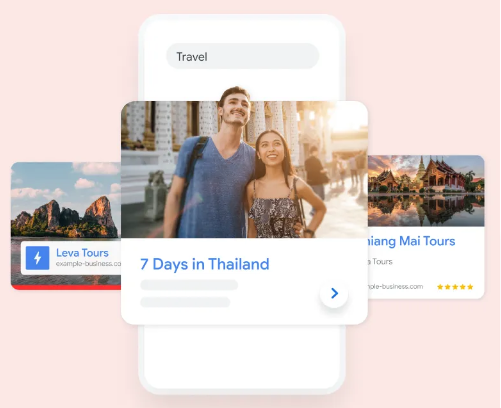
Source: Google Ads
Video Discovery Ads appear in YouTube search results, video recommendations, and video descriptions, featuring a thumbnail image with text. Bumper Ads are short, non-skippable ads (six seconds or less) ideal for branding and awareness.
YouTube Display ads
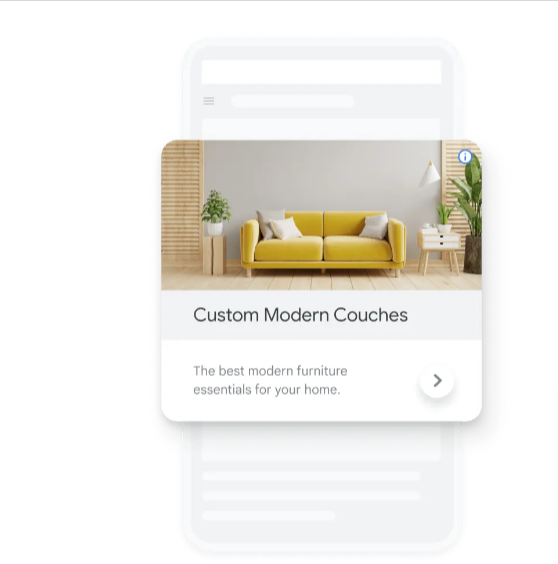
Source: Google Ads
Display ad types comprise Display Ads, which are image or text ads on YouTube’s right-hand sidebar targeted to specific channels, videos, or audiences. Overlay Ads are transparent ads overlaying videos and can be text, image, or interactive.
YouTube Overlay ads
Overlay ads are the type of advertisements that can feature text, images, or a combination of both. These ads can include promotions and branding designed to encourage viewers to click through to your website. These ads appear on the desktop only.
Typically, overlay ads appear as semi-transparent banners across the lower part of a YouTube video. As the name suggests, they “overlay” the video content without fully interrupting it. These ads are only displayed on desktop or laptop screens.
By using overlay ads, you can engage users while they’re watching videos, delivering a message with both visuals and text without needing to produce a full video ad. This makes overlay ads a flexible and straightforward option for driving traffic to your website and boosting visibility.
TrueView or skippable video ads
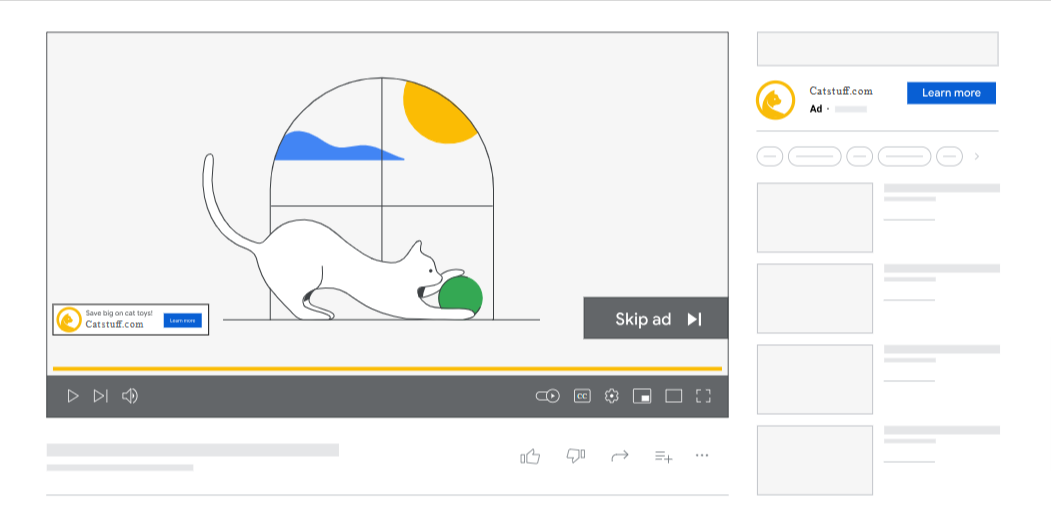
Source: Google Ads
Skippable or TrueView video ads are short promotional videos that play before, during, or after a YouTube video. Users have the option to skip the ad after five seconds, allowing you to capture their attention quickly with engaging content. These ads are designed to encourage action—whether that’s visiting your website, watching your video, or making a purchase.
TrueView ads are accessible across all devices, meaning your audience can encounter them on smartphones, tablets, desktop computers, game consoles, or smart TVs. Regardless of the platform, these ads allow you to reach a wide audience and drive interest in your brand, products, or services.
Non-skippable video ads
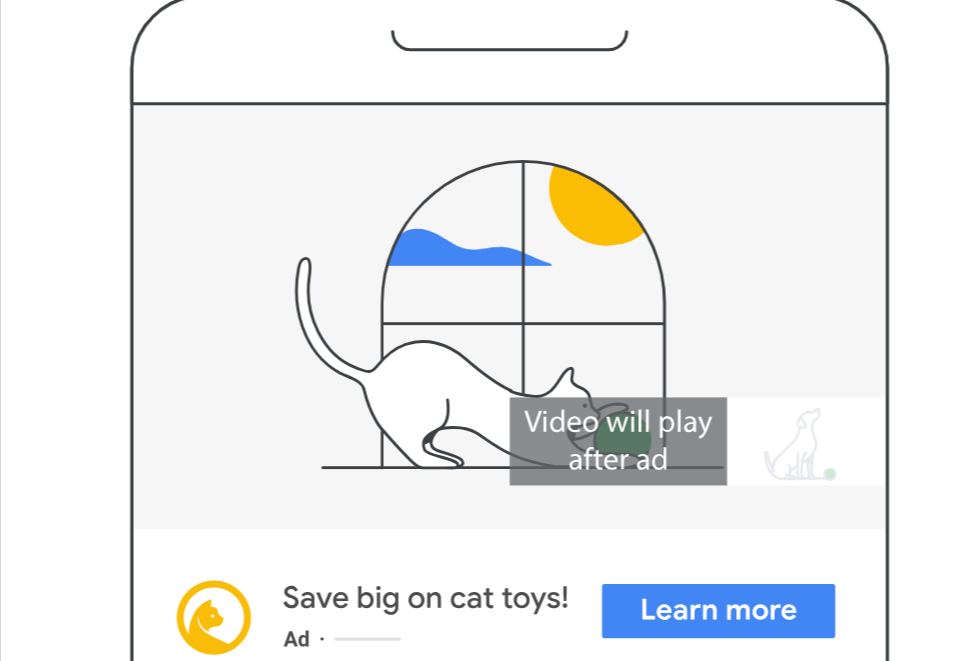
Source: Google Ads
Non-skippable video ads are another impactful option in YouTube advertising. These ads typically run for 15 to 20 seconds and play before, during, or after a video. Since these ads cannot be skipped, viewers are required to watch the entire ad before they can view or resume the content they initially wanted to watch, whether they’re on a mobile device or desktop.
Non-skippable ads can also be shown at the end of a video. Similar to TrueView ads, they appear in the same space as the main video, ensuring they capture full attention.
Bumper ads
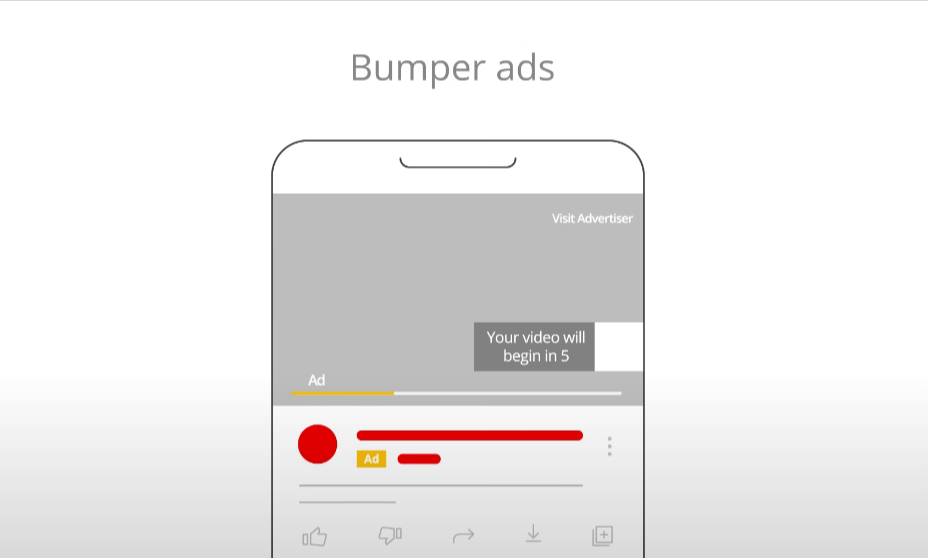
Source: Google Ads
For a quicker way to share a promo or important message with your audience in a way you can be sure they’ll see, bumper ads are a great choice. These short, non-skippable video ads blend the features of both skippable and non-skippable ads, offering a concise, impactful way to reach viewers. These ads are non-skippable and run for 6 seconds.
They appear where the main video displays.
Interactive ads
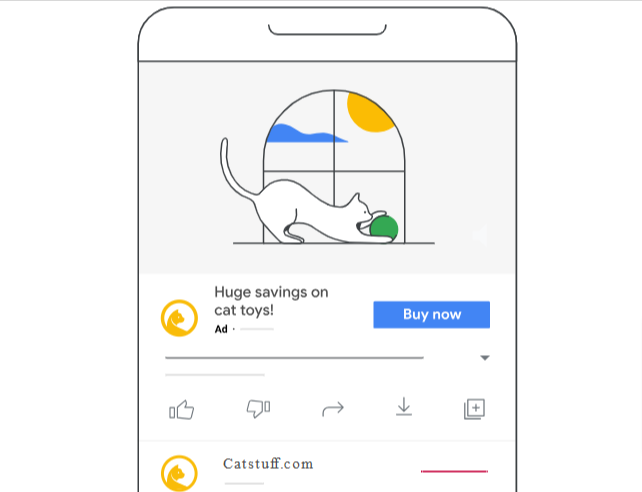
Source: Google Ads
Interactive ad types include interactive cards, which engage viewers with polls, quizzes, or links during videos or in video descriptions. End Screens are visual elements at the end of videos encouraging viewers to subscribe, visit websites, or engage.
YouTube Ad Targeting and Pricing
YouTube’s ad targeting options include Demographic Targeting (age, location, language), Interest Targeting (hobbies, interests, topics), Behavioral Targeting (user behaviour), Contextual Targeting (video content, keywords), and Lookalike Targeting (similar audiences to existing customers).
Ad pricing models include Cost-Per-View (CPV), paying for video views; Cost-Per-Click (CPC), paying for ad clicks; and Cost-Per-Thousand Impressions (CPM), paying for ad impressions.
To create effective YouTube advertising campaigns, consider best practices such as using attention-grabbing thumbnails, optimizing ad targeting, A/B testing, monitoring ad metrics, and adjusting budgets. Now that you have learned about the types and the pricing let us look into the benefits that you gain out of using YouTube ads for your client’s business.
What Are the Benefits of YouTube Advertising?
1. Increased Visibility
YouTube boasts an impressive 2 billion monthly active users, providing unparalleled exposure for businesses. This vast audience presents a significant opportunity to increase brand visibility, reach potential customers, and drive engagement.
2. Reach Worldwide
YouTube’s accessibility in over 80 languages enables businesses to reach international audiences, expanding their global footprint. This feature allows companies to target specific regions, languages, and cultures, tailoring their advertising efforts to resonate with diverse audiences worldwide.
3. Targeted Advertising
YouTube’s targeted advertising capabilities empower businesses to precisely reach their desired audience, maximizing ad effectiveness and efficiency. By targeting specific demographics, interests, and behaviours, advertisers can identify and engage with their ideal customer base.
This targeted approach ensures that ads resonate with viewers, fostering meaningful connections and driving conversions. Additionally, targeted advertising increases ad relevance and effectiveness, reducing wasted ad spend on non-targeted audiences.
4. Cost-Effective
YouTube advertising offers an attractive cost-effective solution for businesses. The pay-only-for-views model ensures advertisers only pay for actual ad views, eliminating unnecessary expenses.
Competitive CPC rates provide flexibility in budget allocation, allowing businesses to optimize their ad spend. Daily or total campaign budgets enable advertisers to set and manage their spending, ensuring alignment with marketing objectives.
5. Measurable Results
YouTube advertising provides actionable insights through measurable results, empowering businesses to optimize their campaigns. Advertisers can track:
- Views, clicks, engagement, and conversions
- Audience retention, drop-off points, and earnings
- Campaign performance across devices and platforms
6. Brand Awareness and Recognition
YouTube advertising plays a pivotal role in establishing and strengthening brand identity and credibility. By consistently showcasing your brand’s message, values, and unique selling proposition, you can build brand recognition and recall among your target audience.
YouTube advertising drives targeted traffic to your website, increasing the likelihood of converting viewers into customers.
7. Driving Website Traffic and Sales
YouTube advertising is a potent driver of targeted website traffic and sales. By strategically placing ads in front of relevant audiences, you can direct high-quality traffic to your website, increasing the potential for leads and conversions. YouTube’s advanced targeting options ensure that your ads reach users who are actively seeking products or services like yours.
This targeted approach maximizes the effectiveness of your ad spend, driving meaningful results for your business.
8. Diversified Advertising Options
YouTube offers an array of advertising formats to suit diverse business objectives and creative strategies. Video ads, display ads, interactive ads, and more provide flexibility in crafting compelling campaigns. In-stream ads, bumper ads, and video discovery ads enable you to reach viewers during video playback.
Display ads, overlay ads, and sponsored cards offer additional touchpoints for engagement. Interactive ads, such as cards and end screens, facilitate viewer interaction and conversion.
9. Competitive Advantage
Targeted YouTube advertising affords businesses a significant competitive advantage. By precision-targeting specific demographics, interests, and behaviors, you can outmaneuver competitors and establish market dominance.
This targeted approach enables you to differentiate your brand, establish thought leadership, and build customer loyalty. By leveraging YouTube’s vast audience and advanced targeting options, businesses can outshine competitors and achieve sustainable growth.
10. Long-Term Benefits
YouTube advertising yields long-term benefits that extend beyond immediate campaign results. By consistently engaging with your target audience, you can foster brand loyalty, retention, and advocacy.
This loyal customer base becomes a powerful marketing force, driving word-of-mouth referrals and positive reviews. Moreover, YouTube advertising helps establish your brand as a trusted authority in its niche, attracting new customers and talent.
Setting Up a YouTube Advertising Campaign
Here’s a step-by-step guide to setting up a YouTube advertising campaign:
Step 1: Create a Google Ads Account
1. Go to ads.google.com and sign up.
2. Verify your email address and set up billing.
Step 2: Set Up Your YouTube Campaign
1. Log in to Google Ads.
2. Click “Campaigns” and then “New Campaign.”
3. Select “Video” as the campaign type.
4. Choose “YouTube” as the platform.
Step 3: Define Campaign Settings
1. Set campaign name and budget.
2. Choose a bidding strategy (CPV, CPC, or CPM).
3. Set start and end dates.
4. Select target locations and languages.
Step 4: Choose Ad Format
1. Select ad format: In-Stream, Video Discovery, Bumper, or Display.
2. Upload ad creative assets (video, image, or text).
Step 5: Target Your Audience
1. Demographic targeting: age, location, language.
2. Interest targeting: hobbies, interests, topics.
3. Behavioral targeting: user behavior, video engagement.
4. Custom targeting: upload customer lists or lookalike audiences.
Step 6: Set Ad Scheduling and Rotation
1. Schedule ads to run continuously or at specific times.
2. Rotate ad creatives to optimize performance.
Step 7: Monitor and Optimize
1. Track ad performance: views, clicks, engagement, conversions.
2. Analyze audience retention and drop-off points.
3. Adjust targeting, bidding, or ad creative to optimize performance.
YouTube Ad Specifications you need to know
Here are a few detailed specifications to keep in mind while uploading
- Video ads: 12-60 seconds, 16:9 aspect ratio.
- Display ads: 300×250, 320×50, or 300 x 600 pixels.
- Image ads: JPEG, PNG, or GIF, 72 dpi.
Common Challenges and Solutions in YouTube Advertising
Here are common challenges and solutions in YouTube advertising:
1. Ad Viewability and Engagement
- Low view-through rates
- Short watch times
Solution: Optimize ad creative, targeting, and placement.
2. Ad Fraud and Brand Safety
- Invalid traffic
- Inappropriate content
Solution: Utilize Google’s brand safety tools and third-party verification.
3. Targeting and Reach
- Inaccurate targeting
- Limited reach
Solution: Refine targeting options, use custom audiences, and layer targeting strategies.
4. Measuring ROI and Conversions
- Difficulty tracking conversions
- Limited ROI visibility
Solution: Set up conversion tracking, use Google Analytics, and monitor ROI metrics.
5. Ad Length and Format
- Ad length limitations
- Format restrictions
Solution: Utilize various ad formats (e.g., bumper ads, display ads).
Why do advertisers choose YouTube ads?
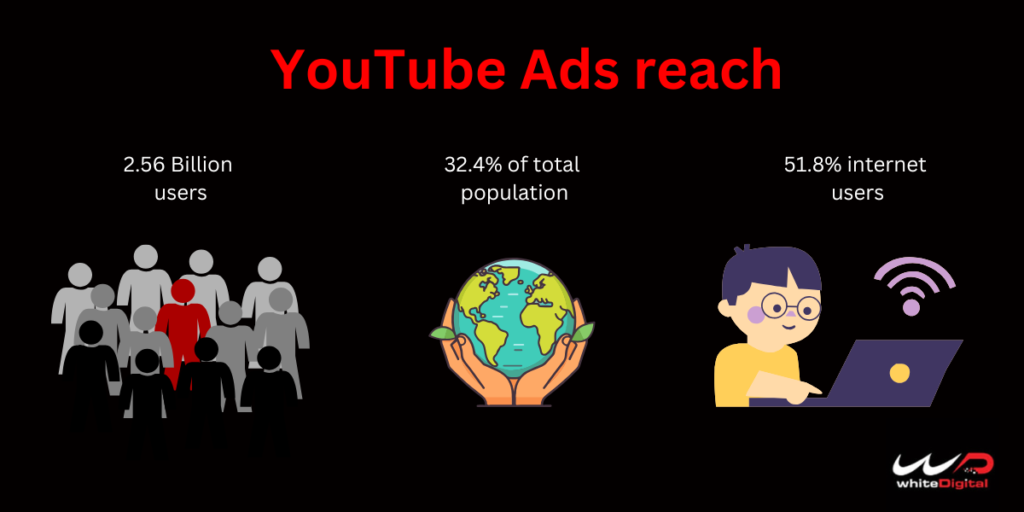
There are many reasons why advertisers can choose YouTube ads when compared with other platforms for advertising. Some of the reasons include,
- They can reach out the brand to a better level of audience
- They can target according to their need. This can be done on other platforms as well.
- Video content grabs the attention of the audience compared to image ads.
- A huge variety of ad formats
- Cost-effective when compared with other platforms.
These are some of the reasons, yet there are numerous other reasons as well.
YouTube Advertising Trends and Best Practices for 2024
YouTube advertising trends and best practices for 2024 are all about leveraging the latest technologies and strategies to reach your target audience effectively.
- AI-Powered Advertising: With Google Ads’ Maximize Conversion Value and Demand Gen campaigns, businesses can optimize their ad spending and reach their target audience more effectively.
- Long-Form Video Content: YouTube is shifting focus from short-form to long-form content, allowing for more in-depth storytelling and audience engagement.
- Short-Form Video Marketing: Short-form videos, like YouTube Shorts, are still popular for quick, engaging content.
- Silent Videos: Many users watch videos without sound, so optimizing for silent viewing is crucial.
- Personalized Videos: Using AI to create personalized videos can boost engagement and conversion rates.
- User-Generated Content: Encouraging users to create content can build trust and credibility.
- Cross-Platform Marketing: Sharing content across multiple platforms, including YouTube, social media, and blogs, can expand your reach.
Best Practices:
- Thumbnail Split Testing: Use YouTube’s built-in feature to test and optimize thumbnails for better engagement.
- Educational Content: Create informative, high-quality content to establish authority and expertise.
- Live Video and Virtual Events: Engage with your audience through live streams and virtual events.
- Video Content for SEO: Optimize your videos for search engines to improve visibility.
By incorporating these trends and best practices into your YouTube advertising strategy, you can increase engagement, conversion rates, and overall ROI.
Key Takeaways
YouTube advertising holds massive potential to help you reach the target audience and get more conversions. If you are finding it difficult to run YouTube ads for your client, get help from a leading YouTube ads expert who knows all the nooks and corners of YouTube ads.

